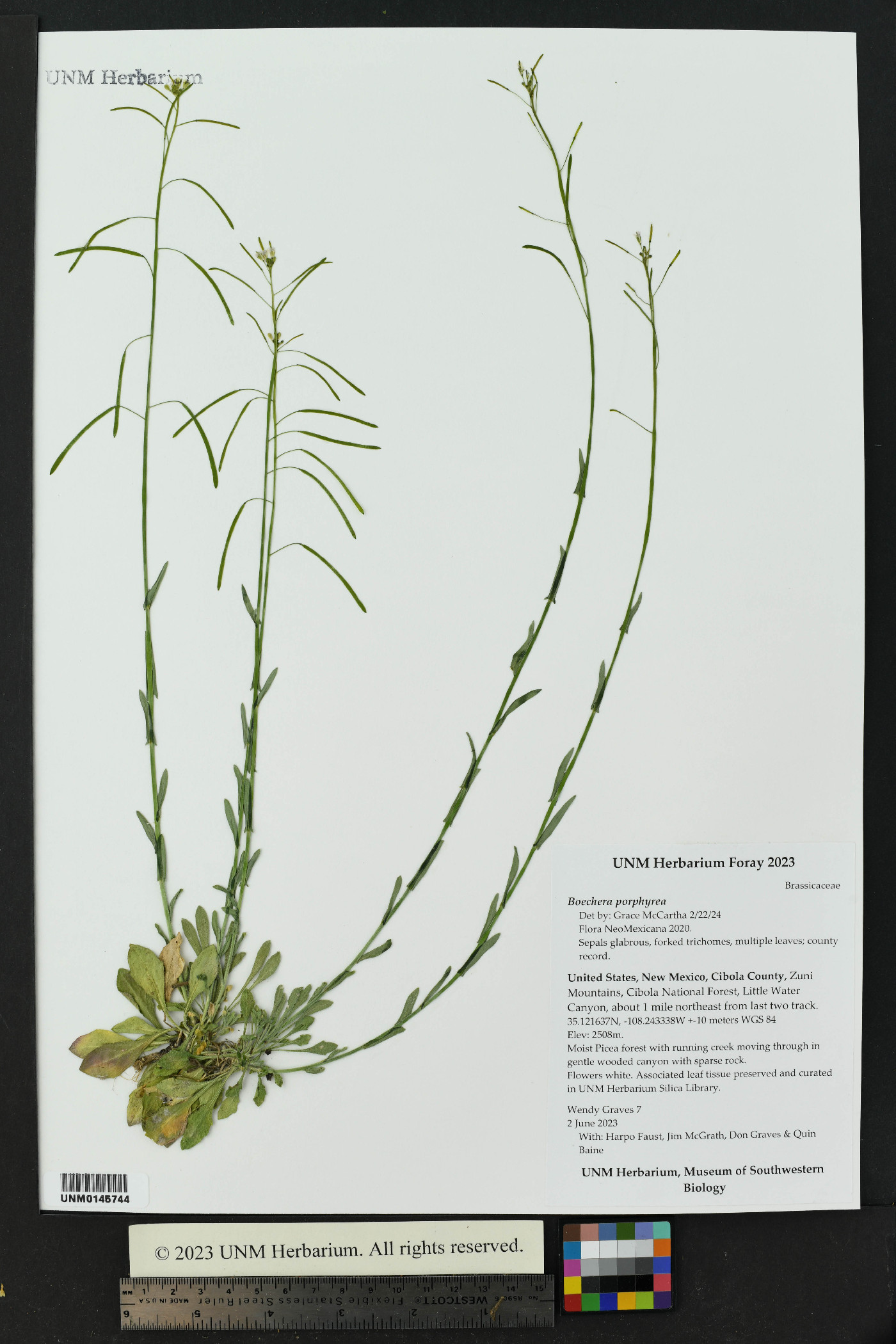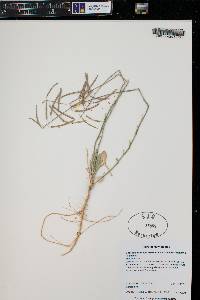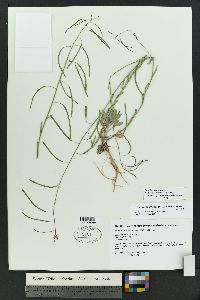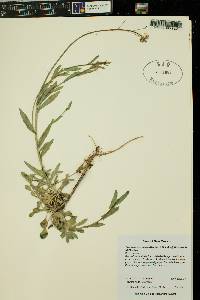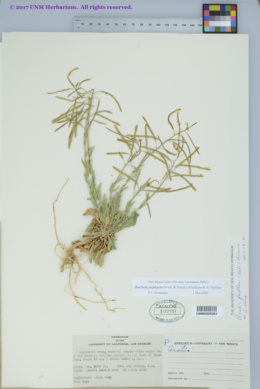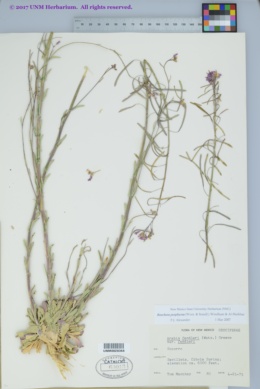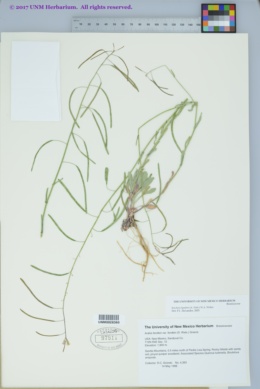
|
|
|
|
Family: Brassicaceae
[Arabis porphyrea Woot. & Standl.] |
Perennials; usually long-lived; apomictic; caudex often woody. Stems 1 to several per caudex branch, arising from center of rosette or arising laterally proximal to sterile shoots, somewhat elevated on woody base or from ground surface, 2-5 (-9) dm, usually glabrous proximally, rarely sparsely pubescent, trichomes simple and short-stalked, 2- or 3-rayed, 0.1-0.5 mm, glabrous distally. Basal leaves: blade oblanceolate, (3-)5-15 mm wide, margins dentate, ciliate at least along petiole, trichomes to 1 mm, surfaces pubescent, trichomes short-stalked, 2-6-rayed, 0.1-0.5 mm. Cauline leaves: 5-17(-21), sometimes concealing stem proximally; blade auricles 0.5-3.5(-5.5) mm, surfaces of distalmost leaves glabrous. Racemes 10-30(-70)-flowered, usually unbranched. Fruiting pedicels horizontal, gently curved downward, 10-27 mm, glabrous. Flowers ascending at anthesis; sepals glabrous; petals lavender, 6.5-8.5 × 1-2.5 mm, glabrous; pollen spheroid. Fruits widely pendent, not appressed to rachis, not secund, usually curved, edges parallel, 3-7 cm × 1.8-2.5 mm; valves glabrous; ovules 100-160 per ovary; style 0.2-0.5 mm. Seeds sub-biseriate, 1.1-1.6 × 0.9-1.1 mm; wing continuous, 0.1-0.2 mm wide. Flowering late Mar-early May. Rocky slopes in evergreen woodlands or desert scrub; 1200-2100 m; N.Mex., Tex. Morphological evidence suggests that Boechera porphyrea is an apomictic species that arose through hybridization between B. texana and B. perennans (see M. D. Windham and I. A. Al-Shehbaz 2007 for detailed comparison).
FNA 2010, Allred and Ivey 2012 Duration: Perennial Nativity: Native Lifeform: Forb/Herb General: Long lived perennial herbs, 20-90 cm tall, from an often woody caudex; stems one to several per caudex branch, arising from the center of basal rosettes or (more often) laterally from the base of sterile shoots, the rosettes and sterile shoots sometimes elevated on a woody base; stems glabrous, rarely sparsely pubescent near the base with 2-3 rayed stellate hairs. Leaves: Basal leaves petiolate, clustered in distinct rosettes; stem leaves alternate, sessile; basal blades oblanceolate, 3-15 mm wide, with dentate margins, the surfaces pubescent with short-stalked, 2-6-rayed stellate hairs; stem leaves numerous, sometimes concealing the stem, the base of the blades clasping the stem with auricles 0.5-5.5 mm; uppermost stem leaves hairless. Flowers: Lavender, in terminal racemes of 10-70 flowers on 1-3 cm pedicels, these ascending in flower and horizontal or gently curved downward when in fruit; sepals 4, glabrous; petals 4 in a cross formation, lavender, 6-9 mm long and 1-2 mm wide. Fruits: Capsules linear, 3-7 cm long and 2 mm wide, usually curved, glabrous, widely pendant; seeds 1 mm long, winged, usually in about 2 rows per locule. Ecology: Found on rocky slopes in evergreen woodlands or desert scrub, from 4,000-7,000 ft (1219-2134 m); flowers late March-early May. Distribution: NM, TX Notes: Because of hybridization, polyploidy, and self-fertilization, Boechera is an extremely problematic group. There have been several re-organizations of this group over the years (including splitting it out from the genus Arabis). For simplicity it is better to use a recent treatment to identify your plants; this description is based on the Flora of North America treatment (2010) and the key divisions in the Flora Neomexicana (Allred and Ivey 2012). According to FNA, morphological evidence suggests that Boechera porphyrea is an apomictic (self-fertilizing) species that arose through hybridization between B. texana and B. perennans. This species differs from others in the genus based on this combination of traits: sepals are hairless; lower portions of stems are usually hairless but occasionally are sparsely covered with stellate hairs; leaves have toothed edges (B. fendleri has leaves with smooth edges); and capsules are 2 mm diameter (B. texana has capsules 3 mm diameter). Ethnobotany: Unknown Etymology: Boechera is named after Tyge Wittrock Boecher (1909-1983), a Danish botanist, ecologist, and plant geographer; porphyrea is derived from porphyra, the Greek word for the Tyrian Purple, or royal purple dye which in ancient times was laboriously extracted from predatory sea snails of the genus Murex. Editor: AHazelton 2017 |
This project was made possible in part by the Institute of Museum and Library Services [MG-70-19-0057-19].
Powered by Symbiota

